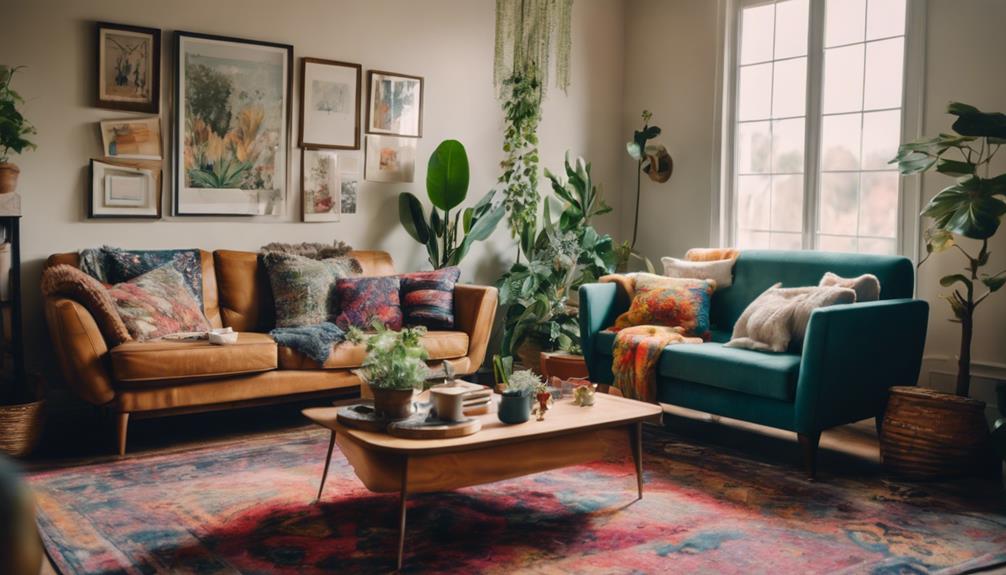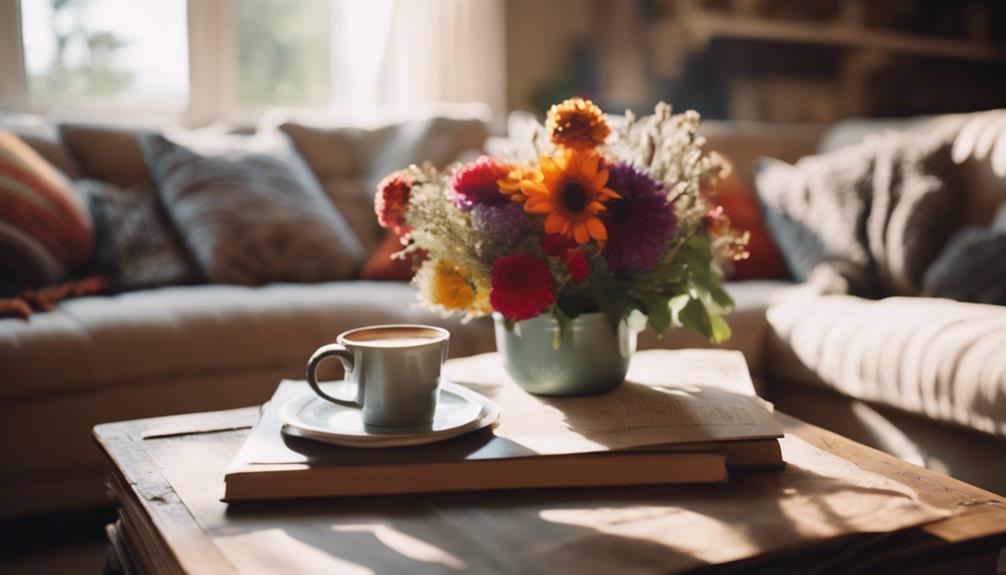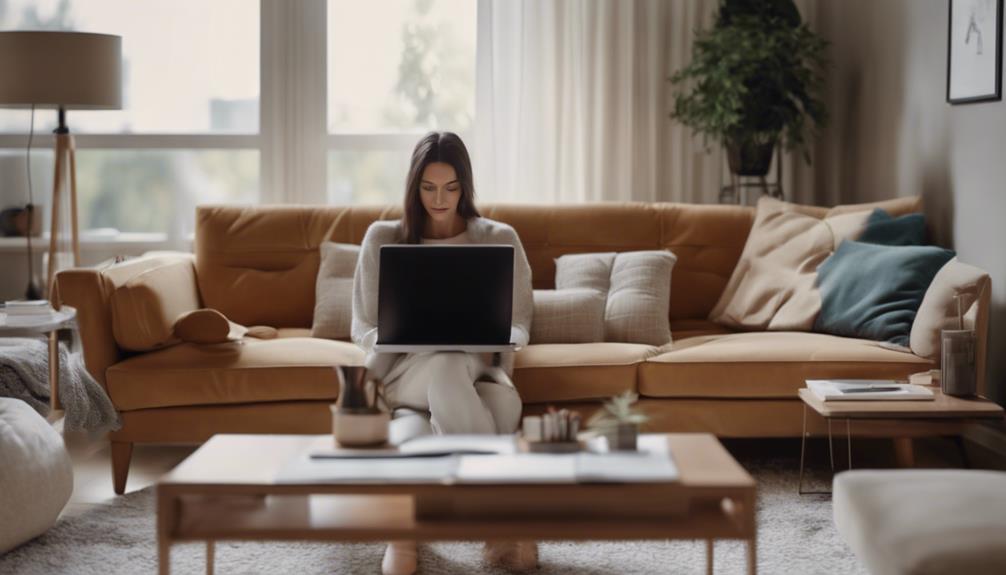When selecting colors for your home decor like a professional designer, it’s essential to grasp the fundamentals of color theory. Use the color wheel to explore complementary and analogous schemes, and aim for balance with the 60-30-10 ratio. Experiment with light and dark shades to create depth, and consider harmonizing colors that are close by on the wheel or try out triad schemes for a different look. Whether you prefer pastels for a calm atmosphere or bold cozy hues for a warmer feel, make sure to add a personal touch with your favorite colors. These designer techniques can help elevate your space and give it a sophisticated appearance. Keep in mind the overall aesthetic and theme of your home decor style when choosing colors – for a modern and minimalist look, consider a monochromatic color scheme with sleek neutrals. If you lean towards a rustic or farmhouse style, incorporate warm, earthy tones. Feel free to experiment with unexpected color combinations to inject some personality into your space. Ultimately, the colors you select should reflect your personal style and complement the overall ambiance of your home decor.
Key Takeaways
- Understand color theory basics for cohesive palettes.
- Utilize contrast for depth and visual impact.
- Choose harmonious color combinations for balance.
- Create serenity with pastel hues for tranquility.
- Personalize your color palette to reflect style.
Color Theory Basics
Understanding color theory basics is crucial for selecting harmonious and visually appealing home decor colors. Color theory explains how colors interact and create harmony in design. By grasping the color wheel, you can easily identify complementary colors, which are opposite each other on the wheel, and analogous color schemes, which are adjacent. These combinations help in creating a balanced and aesthetically pleasing color palette for your living space.
One fundamental principle in color theory is the 60-30-10 ratio. This rule suggests using 60% of a dominant color, 30% of a secondary color, and 10% of an accent color in your decor. Following this ratio ensures that the colors in your room are well-balanced and visually appealing.
Additionally, understanding color theory guides designers in selecting colors that evoke specific moods and emotions, allowing you to create an atmosphere that aligns with your desired ambiance. By incorporating harmonious color combinations based on color theory principles, you can transform your home into a beautifully cohesive space.
Utilizing Contrast in Design
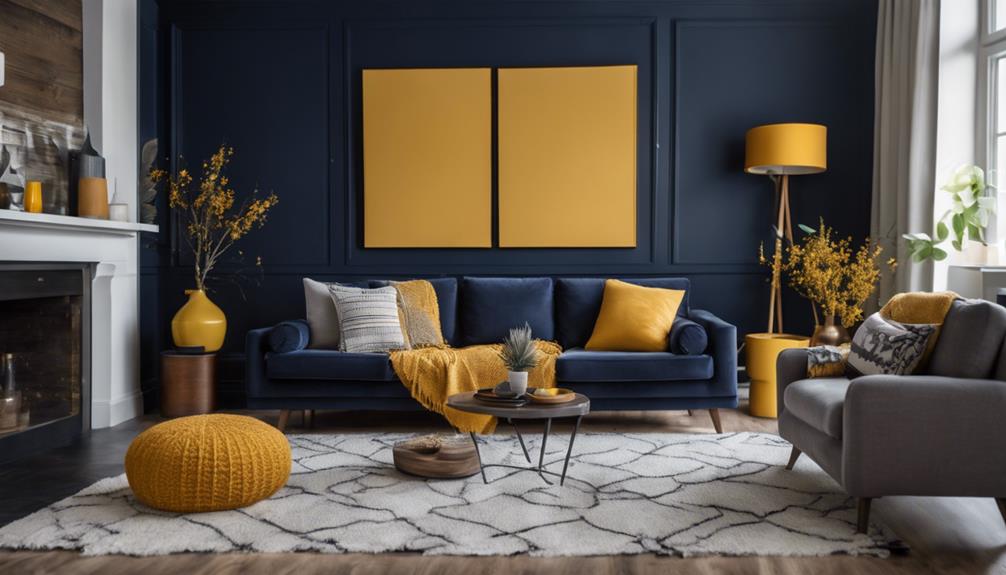
When designing your home decor, remember to utilize contrast effectively by incorporating light shades on flat surfaces and dark shades on indented surfaces to create visual interest.
Enhancing contrast can be achieved by hanging artwork on dark niche surfaces or using them as a backdrop for furniture, adding depth and dimension to the space.
Consider selecting seating furniture in a lighter shade to contrast with dark niche areas, creating a striking visual impact in your home.
Light Vs Dark Surfaces
To create a visually striking contrast in your home decor, consider utilizing light and dark surfaces strategically in your design. Light shades on flat surfaces and dark shades on indented surfaces can create a dynamic interplay of light and shadow, enhancing the overall visual contrast in your home.
For example, hanging paintings on dark niche surfaces or using them as a background for furniture can amplify the visual impact of your decor.
When selecting your furniture, opting for seating in a lighter shade can create a bold contrast against dark niche surfaces, drawing attention to key areas of your design. To further elevate the contrast, consider pairing vibrant colors like purple, red, green, orange, or blue with harmonious colors to achieve a balanced and visually appealing aesthetic.
Incorporating pastel shades such as beige, cream, or white alongside these vibrant hues can add depth and sophistication to your home design.
Furniture Color Contrast
For an impactful home decor scheme, strategically incorporating contrasting colors in your furniture can elevate the visual appeal of your living space. Furniture color contrast not only adds visual interest but also creates depth in your home decor.
Light shades on seating furniture can be paired with dark niche surfaces to achieve a balanced look, while dark niche surfaces can provide a striking backdrop for vibrant furniture colors to stand out.
Harmonious Color Combinations
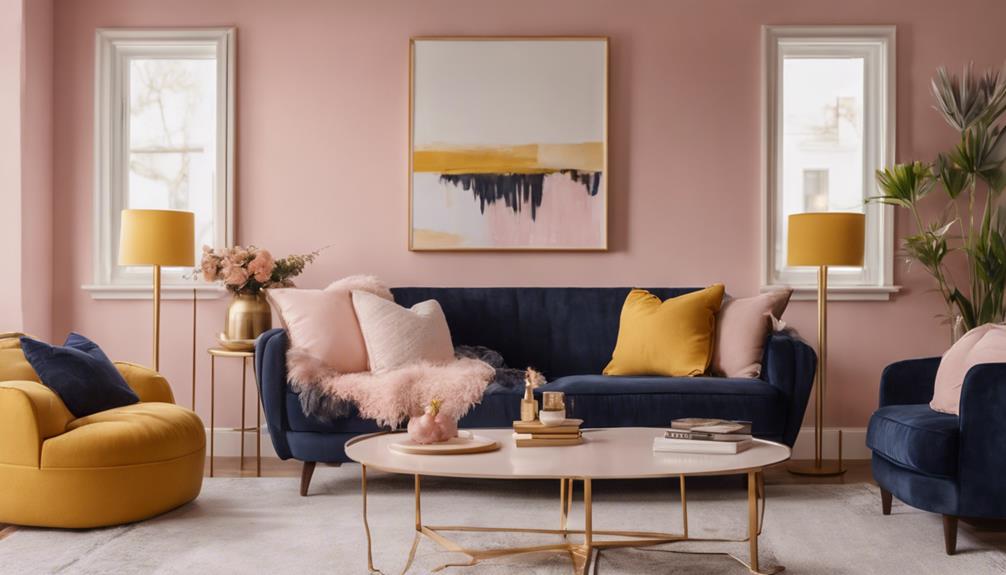
Pair harmonious colors together by selecting hues that are adjacent on the color wheel for a cohesive and pleasing aesthetic in your home decor. Creating a harmonious color scheme is essential in interior design to achieve a balanced and visually appealing space.
Complementary colors, like blue and orange, can be combined to create a striking yet harmonious look that enhances the overall ambiance of a room. Analogous colors, such as green, yellow, and yellow-green, offer a soothing and cohesive effect when used together in home decor.
For a vibrant and balanced color combination, consider utilizing triad palettes with colors like red, yellow, and blue. If you're looking for a more dynamic and diverse color scheme, tetrad palettes, which include four evenly spaced colors on the color wheel, can add depth and interest to your home decoration.
Creating Serenity With Pastels
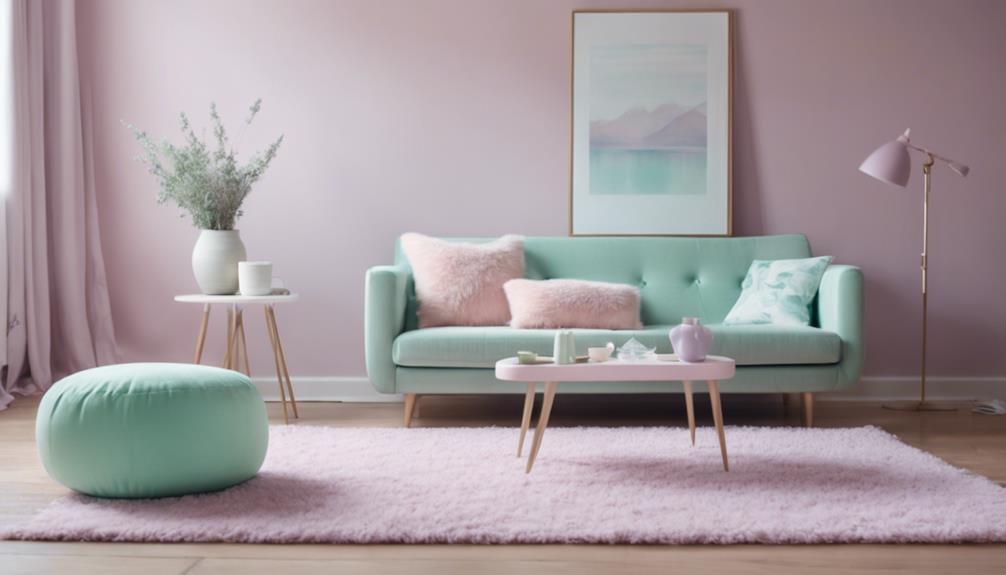
Soft pastel colors exude tranquility and simplicity, setting the tone for a serene ambiance in your home decor. When aiming to create serenity with pastels, consider the following tips:
- Pastel Color Palettes: Opt for light pastel shades like pale yellow, blue, or green to promote a sense of tranquility in your living space.
- Soothing Effect: These soft hues help in creating a relaxed atmosphere without overwhelming the eyes, perfect for unwinding after a long day.
- Darker Furniture: Pairing pastel or neutral wall paints with darker furniture adds depth and elegance to your decor, offering a striking contrast.
- Harmonious Look: By incorporating pastel shades, you can achieve a harmonious look in your home, balancing out the vibrancy of darker furniture for a cohesive and calming environment.
With these elements in place, your home will radiate a sense of peace and tranquility, making it a serene sanctuary for you to enjoy.
Color Palette Selection Tips
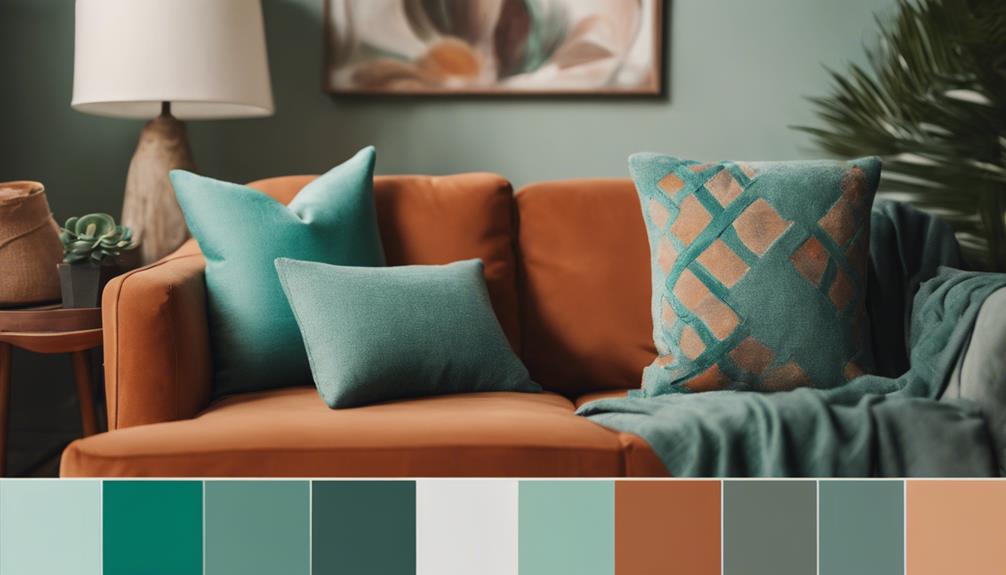
When selecting a color palette for your home decor, it's essential to consider the basics of color harmony. This involves understanding how different colors work together to create a cohesive and pleasing aesthetic.
Choosing accent colors thoughtfully is another crucial aspect of creating a well-balanced color scheme. Accent colors can add depth and interest to a room, so it's important to select them carefully to complement the main colors in your palette.
Additionally, you can create different moods in your home by experimenting with various color combinations. Warm colors like red, orange, and yellow can evoke a sense of coziness and intimacy, while cool colors like blue and green can create a calming and tranquil atmosphere.
Color Harmony Basics
Understanding the basics of color harmony involves selecting a color palette that includes dominant, secondary, and accent colors. To create a cohesive color palette for your interior design, consider the following tips:
- Explore Different Color Harmonies: Experiment with various color harmonies like complementary, analogous, or triadic to find what suits your style best.
- Choose a Dominant Color: Select a primary color that will be the main focus of your decor scheme, setting the tone for the entire room.
- Utilize Secondary Colors: Incorporate secondary colors that complement the dominant hue, adding depth and interest to the space.
- Balance with Accent Colors: Introduce accent colors sparingly to highlight specific elements or create visual pops throughout the room.
Choosing Accent Colors
Select accent colors that complement your dominant colors to enhance the visual appeal and cohesion of your home decor.
When choosing accent colors, consider hues that harmonize with the main colors in the room. These accent colors can be used strategically to add visual interest and balance to the overall color scheme.
Opt for bolder shades or contrasting tones to create focal points and draw attention to specific areas or elements within the space. Accessories, artwork, or small furniture pieces in accent colors can be great ways to introduce these pops of color while maintaining a cohesive look.
By incorporating accent colors that work well with your dominant colors, you can elevate the vibrancy and style of your home decor, creating a harmonious and visually appealing environment.
Creating Mood With Colors
To evoke specific emotions and set the tone of a room, carefully select colors that resonate with the mood you want to create in your living space.
When choosing colors to create visual harmony and convey a particular ambiance, consider the following tips:
- Warm Tones: Incorporate colors like red, orange, and yellow for a cozy and inviting feel in your home.
- Bold Colors: Opt for vibrant hues such as teal, mustard, or coral to inject energy and personality into your decor.
- Create Visual: Balance the color palette by mixing in neutrals like beige, gray, and white for versatility and sophistication.
- Choosing Colors: Experiment with cool tones like blue, green, and purple to establish a calming and relaxing atmosphere in your living spaces.
Decorating Strategies for Color Harmony

Enhance your home decor by incorporating decorating strategies that focus on achieving color harmony through careful selection and placement of hues.
Utilize the color wheel to guide your choices, considering complementary colors that lie opposite each other for a vibrant contrast or analogous color schemes that are adjacent for a more subtle blend.
Adhere to the 60-30-10 ratio when selecting colors for your space, with 60% for a dominant color, 30% for a secondary color, and 10% for an accent color to create a well-balanced look.
To maintain a harmonious color palette, incorporate shades from the same color family throughout different elements in your room.
Experiment with various color combinations to evoke specific moods and emotions in each area, ensuring that the colors you choose resonate with the ambiance you wish to create.
Personalizing Your Color Palette
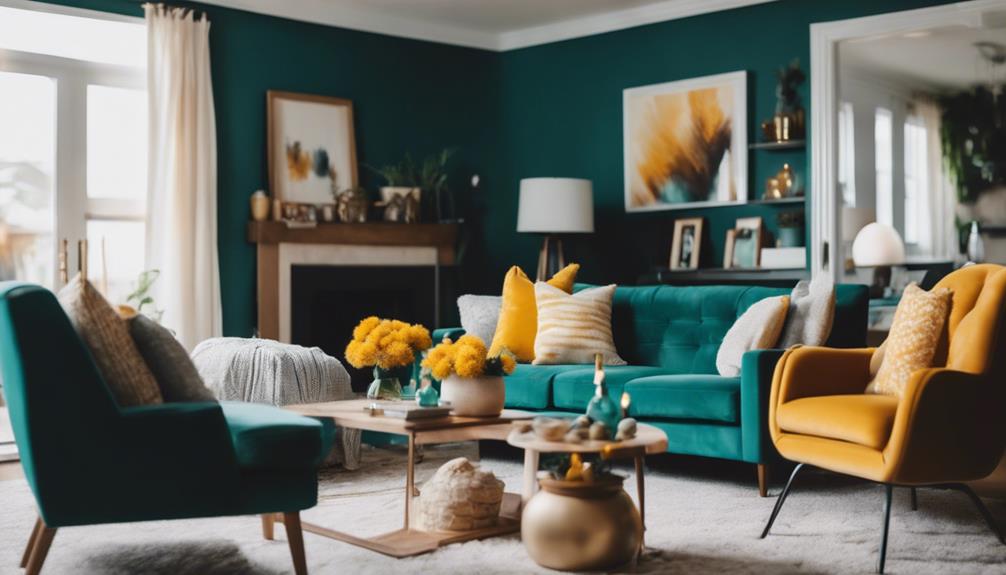
Consider infusing your favorite color as the focal point when personalizing your color palette for your home decor. To add a touch of your individual style to your living spaces, follow these tips:
- Look into Your Wardrobe:
Your wardrobe can be a treasure trove of color inspiration. Take note of the hues that dominate your clothing choices; these shades can seamlessly integrate into your home decor.
- Experiment with Bold and Soothing Shades:
Don't shy away from incorporating both bold and soothing tones of your favorite color in different rooms. A mix of these shades can create dynamic visual interest.
- Use Your Favorite Color as an Accent:
By using your favorite color as an accent throughout various spaces, you can tie the rooms together and establish a cohesive color palette.
- Reflect Your Individual Style:
Personalizing your color palette allows you to showcase your unique taste and personality in your home decoration choices.
Frequently Asked Questions
What Is the 3 Color Rule in Interior Design?
In interior design, the 3 color rule involves picking a dominant, secondary, and accent color. The dominant should cover 60%, secondary 30%, and accent 10% of the space. This creates balance and visual interest without overwhelming.
How Do I Choose Harmony Color?
When selecting harmonious colors for your home decor, begin with your preferred shade as a foundation. Explore various tones and shades within the identical color category. Shift accent colors seamlessly between rooms for a unified appearance.
How to Pick a Color Scheme for Interior Design?
To pick a color scheme for interior design, start by pulling colors from existing patterns like upholstery or artwork. Incorporate whites and beiges for neutral walls. Harmonize the colors for a cohesive look that ties everything together beautifully.
How Do Designers Choose Colors?
To choose colors like a designer, start with a dominant color for the base. Then, layer on secondary and accent hues to enhance the room's vibe. Consider textures, finishes, and lighting to guarantee a cohesive design that pleases the eye.
How Can Color Harmony Enhance My Chosen Home Decor Style?
When it comes to creating the perfect home decor style, color harmony plays a crucial role. By understanding how different colors complement each other, you can elevate the overall look and feel of your space. Whether your style is modern, bohemian, or traditional, knowing how to pick home decor style colors can make a significant impact.
Conclusion
Now that you've learned the basics of color harmony and how to pick home decor colors like a designer, it's time to put your newfound knowledge to use! Consider implementing your color choices into your existing design scheme or use them as inspiration for a complete home decor style overhaul. Whether you prefer a modern, minimalist aesthetic or a more traditional, cozy feel, the right color combinations can truly elevate your space. Experiment with different shades and tones to find the perfect balance for your home decor style. Try incorporating elements of your chosen color scheme into your furniture, accessories, and artwork to create a cohesive look. Don’t be afraid to take risks and step outside of your comfort zone – this is your chance to express your personality and creativity through your home decor. By experimenting with various color combinations and design elements, you’ll discover your unique home decor style that reflects who you are and what you love.
Remember, the world is your oyster when it comes to choosing colors for your space. So go ahead, paint the town red (or blue, or green) and create a harmonious and visually stunning home that truly reflects your unique style and personality.
Happy decorating!

